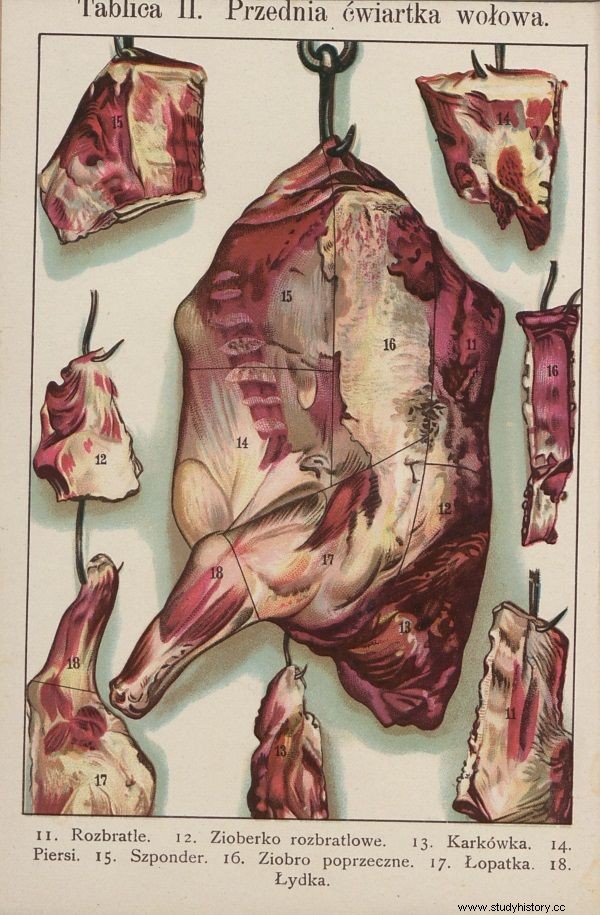Pork chop, tartare and knuckle? Forget it. Game? Only for the young lord, I guess. And hunting bigos? An ordinary Pole would not even know what it is. Check what was really eaten a century ago.
To say that the countryside was hungry before the war is like saying nothing. Seventy percent of the population lived just outside the city, and the vast majority not in charming manor houses, but in simple cottages. In many peasant families poverty screeched, especially in Poland "B".
Today, in every major city, we can find a restaurant that presents itself as a shrine serving real "peasant food". They advertise themselves as relating to traditional cuisine, preferably with pre-war roots.

Feeding piglets from the bottle. (photo:public domain, "Ilustrowany Kuryer Codzienny").
In the menu of such a restaurant, you will find naturally a pork chop in a place of honor, somewhere tartare and pork knuckle will flash, possibly some venison or bigos. AND! And dumplings. There are also dumplings filled to the limit, bathed in fat and sprinkled with greaves. The whole problem is that it all has nothing to do with how ordinary Poles ate before the war.
Pork chop? This is actually new…
In the 19th century, a recipe for pork chop appears in a cookbook , but the classic with a cutlet that has been patched almost onto the paper, breaded several times and fried in oil with the addition of potatoes from water and fried cabbage, became the star of the communist tables. The pork knuckle of a slaughtered hog had to be enough for a week of cooking various specialties, and the recipe for tartare in popular pre-war cookbooks cannot be found.

A colorful graphic showing the cutting of oxen, very useful for gaining practice housewives, comes from the book "Practical Kitchen or a Handbook for Cooking Food and Legumin" by Róża Makarewicz.
Also bigos, although well-known chefs at the time write about it, was rather a specialty from the repertoire of the court kitchen, served to jasmine from the cauldron, along with a glass of stew, during a hunt. As for venison, peasants would not dare to hunt it, and city dwellers would not have anywhere to legally buy it. In short, the menu of such a place with its marketing message can be put into fairy tales. Only dumplings work, although in a much more modest setting.
In fact, the people of the poor farmland were feeding on the poultry (and rarely - it was more profitable to sell a hen than to cook it) and pork, and small and skinny country cows were in no way suitable for a decent steak. The basis of the diets of the poor inhabitants of the village were potatoes, groats, own flour, cabbage, broad beans and everything that could be sown and grown on your own.
Apart from that, people used to draw from the surroundings - much more mushrooms were eaten than today, forest fruit, and fish and crayfish were caught. Information about the latter may be surprising at first glance, but thanks to the clean environment outside the cities, the waters abounded with the above-mentioned crustaceans. In some bodies of water, it was enough to just dip your hand in the wrong place and you could get pinched by cancer on your finger.
The meat happened
In addition, you ate "small" parts of a pig killed for your own needs, which included, among others, ribs or legs. Using them as a base, simple but filling dishes were prepared.
After killing the pig and making cold cuts and other preserves, and preserving some of the fried meat in lard, the rest was salted, with what was to be eaten first. The popular view that in pre-war Poland the inhabitants of villages ate meat only from the great bell does not stand up to the clash with the facts.
In the nineteenth century, thanks to the progress in agriculture, it was possible to increase the yield of crops by several dozen percent. As a result, the surplus could be sold or devoted to breeding, which translated directly into an increase in the number of pigs. The hosts could allocate some of the fattened pigs to the needs of their own family. Families were of different sizes at the time.

Actor Józef Leliwa in an exaggerated portrait showing him eating a meal.
It happened that parents, grandparents, a whole group of children and sometimes a distant relative or farmhand lived under the same roof. With so many members of the household, the supplies ran out earlier and from week to week the meals had less and less pork, but it continued to appear .
Sources:
The article is based on the sources and literature used by the author while working on the book "Twenty years from the kitchen. Culinary history of pre-war Poland ” . The author used, inter alia,:
- Ciepielewski J., A Polish village during the Great Depression of 1929–1935. Materials and documents , Warsaw 1965.
- Goliński S., Reconstruction of the Polish countryside. A village among gardens , Lviv 1918.
- Mrs. Jadwiga, Economical cuisine for hard times. A collection of practical recipes and a dinner plan for the whole year , no.m.w, 1918.
- Rose E., Economic balance of three years of independence , Warsaw 1922.
- Słomka J., Peasant diaries:from serfdom to today , Tarnobrzeg 2012.
- Szumlańska P., A diligent hostess. Meat and Fasting Lunches and Recipes for Preparing Various Dishes, Cheap and Tasty , Toledo 1922.
